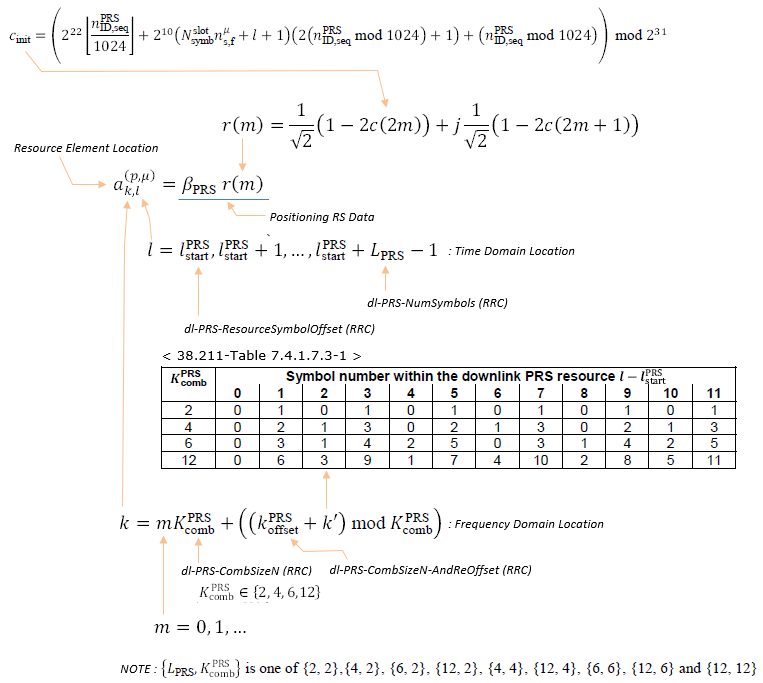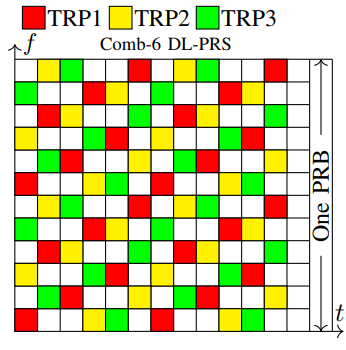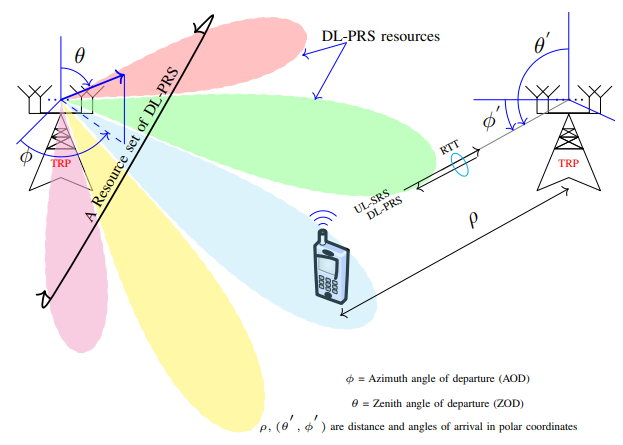|
|
|||||||||||||||||||||||||||||||||
|
The 5G Positioning Reference Signal (PRS) is a specialized feature introduced in 5G networks to enable advanced positioning services, offering high-accuracy location information with centimeter-level precision, a significant improvement over previous generations like 3G and 4G. This capability is essential for a variety of cutting-edge applications, including vehicle navigation for autonomous and connected cars, drone control for delivery and surveillance, and the management of robots in factories, where precise positioning is critical for safe and efficient operation. By leveraging 5G’s wide bandwidth, low latency, and advanced technologies like massive MIMO and beamforming, PRS supports real-time, reliable location tracking both indoors and outdoors, driving innovation in smart cities, industrial automation etc Why PRS ? How to Deploy ?
Compared to LTE, 5G PRS provides wider bandwidths (e.g., 100 MHz in FR1 and 400 MHz in FR2), leading to finer resolution in ToA estimation. Moreover, the paper explains how hybrid approaches, such as PRS-assisted GNSS and sensor fusion, enhance reliability under challenging conditions like urban environments.
In addition PRS transmission schemes can be optimized to reduce energy consumption for low-power positioning for battery-constrained devices such as IoT sensors and wearables. Why separate reference signal like PRS in stead of using SSB ?While both Positioning Reference Signals (PRS) and Synchronization Signal Blocks (SSB) are used in 5G networks, they serve different purposes, and PRS is specifically designed for high-precision positioning, which SSB isn’t optimized for. SSB is too constrained for positioning because of its fixed transmission structure, limited bandwidth, and lack of timing configurability. PRS and SRS, on the other hand, are highly configurable, bandwidth-efficient, and optimized for time-based localization techniques. Following is a comparative tables between SSB and Positioning Oriented Reference signal.
Followings are further breakdown and descriptions of each aspect
Physical Resources for PRS ?Following illustration shows how PRS signal is generated and allocated to 5G/NR physical resource grid. It describes on the initialization sequence c_init using the PRS scrambling identity, the slot number, and other parameters.
ExampleThis example illustrates a case of Comb-6 Downlink Positioning Reference Signal (DL-PRS) allocation across multiple Transmission Reception Points (TRPs) in time-frequency resources.
Image Source : Positioning in 5G networks Followings are some highlights to note
Followings how the physical resource elements are allocated for TRP 1 in this example. Step 1: Recall the Frequency Domain Location Formula k = mKPRScomb + ((kPRSoffset + k') mod KPRScomb)
Step 2: Compute k values for m = 0 and m = 1 For m = 0: k = (0)(6) + (k' mod 6) = k' PRS subcarrier indices: 0, 3, 1, 4, 2, 5, 0, 3, 1, 4, 2, 5 For m = 1: k = (1)(6) + (k' mod 6) = 6 + k' PRS subcarrier indices: 6, 9, 7, 10, 8, 11, 6, 9, 7, 10, 8, 11 Step 3: Final PRS Subcarrier Allocation for TRP1
Step 4: Interpretation
How PRS is utilized ?PRS in 5G is a dedicated downlink signal designed to enhance the accuracy of device localization at the physical layer. It enables high-precision positioning by leveraging time-based and angle-based measurements such as Time Difference of Arrival (TDoA) and Angle of Arrival (AoA). PRS is transmitted in a structured pattern across multiple frequency and time resources, allowing the UE to measure arrival times from different Transmission Reception Points (TRPs). These measurements are then processed to estimate the device's location with sub-meter accuracy. The flexible allocation of PRS in the time-frequency grid helps minimize interference and improve robustness in multipath environments. With the integration of advanced beamforming techniques and wider bandwidths, PRS enhances positioning performance, making it a critical component in applications like emergency response, autonomous vehicles, and industrial automation. Following figure illustrate a possible use case of PRS for high resolution positioning. It depicts a scenario where a UE (e.g, a smartphone) determines its location using PRS signals transmitted from multiple TRPs(e.g, gNB). The PRS signals, labeled as "DL-PRS Resources," are downlink signals sent from the TRPs, shown as red and green lobes extending toward the UE, enabling measurements of distance and angles for accurate positioning.
Image Source : Positioning in 5G networks This is a breakdown and descriptions Multi-TRP Positioning Using PRS This use case illustrates a multi-TRP (Transmission Reception Point) positioning setup, where multiple TRPs transmit Downlink PRS (DL-PRS) and receive Uplink SRS (UL-SRS) from the UE to determine its location. The UE listens to PRS signals and performs positioning measurements such as Time of Flight (ToF), Time Difference of Arrival (TDoA), and Angle of Arrival (AoA). Key Positioning Parameters
Use Case and Benefits This multi-TRP PRS-based positioning is particularly useful for:
RRC ParametersNR-DL-PRS-PDC-Info-r17 ::= SEQUENCE { nr-DL-PRS-PDC-ResourceSet-r17 NR-DL-PRS-PDC-ResourceSet-r17 OPTIONAL, -- Need R ... }
NR-DL-PRS-PDC-ResourceSet-r17 ::= SEQUENCE { periodicityAndOffset-r17 NR-DL-PRS-Periodicity-and-ResourceSetSlotOffset-r17, numSymbols-r17 ENUMERATED {n2, n4, n6, n12, spare4, spare3, spare2, spare1}, dl-PRS-ResourceBandwidth-r17 INTEGER (1..63), dl-PRS-StartPRB-r17 INTEGER (0..2176), resourceList-r17 SEQUENCE (SIZE (1..maxNrofPRS-ResourcesPerSet-r17)) OF NR-DL-PRS-Resource-r17, repFactorAndTimeGap-r17 RepFactorAndTimeGap-r17 OPTIONAL, -- Need S ... }
NR-DL-PRS-Periodicity-and-ResourceSetSlotOffset-r17 ::= CHOICE { scs15-r17 CHOICE { n4-r17 INTEGER (0..3), n5-r17 INTEGER (0..4), n8-r17 INTEGER (0..7), n10-r17 INTEGER (0..9), n16-r17 INTEGER (0..15), n20-r17 INTEGER (0..19), n32-r17 INTEGER (0..31), n40-r17 INTEGER (0..39), n64-r17 INTEGER (0..63), n80-r17 INTEGER (0..79), n160-r17 INTEGER (0..159), n320-r17 INTEGER (0..319), n640-r17 INTEGER (0..639), n1280-r17 INTEGER (0..1279), n2560-r17 INTEGER (0..2559), n5120-r17 INTEGER (0..5119), n10240-r17 INTEGER (0..10239), ... }, scs30-r17 CHOICE { n8-r17 INTEGER (0..7), n10-r17 INTEGER (0..9), n16-r17 INTEGER (0..15), n20-r17 INTEGER (0..19), n32-r17 INTEGER (0..31), n40-r17 INTEGER (0..39), n64-r17 INTEGER (0..63), n80-r17 INTEGER (0..79), n128-r17 INTEGER (0..127), n160-r17 INTEGER (0..159), n320-r17 INTEGER (0..319), n640-r17 INTEGER (0..639), n1280-r17 INTEGER (0..1279), n2560-r17 INTEGER (0..2559), n5120-r17 INTEGER (0..5119), n10240-r17 INTEGER (0..10239), n20480-r17 INTEGER (0..20479), ... }, scs60-r17 CHOICE { n16-r17 INTEGER (0..15), n20-r17 INTEGER (0..19), n32-r17 INTEGER (0..31), n40-r17 INTEGER (0..39), n64-r17 INTEGER (0..63), n80-r17 INTEGER (0..79), n128-r17 INTEGER (0..127), n160-r17 INTEGER (0..159), n256-r17 INTEGER (0..255), n320-r17 INTEGER (0..319), n640-r17 INTEGER (0..639), n1280-r17 INTEGER (0..1279), n2560-r17 INTEGER (0..2559), n5120-r17 INTEGER (0..5119), n10240-r17 INTEGER (0..10239), n20480-r17 INTEGER (0..20479), n40960-r17 INTEGER (0..40959), ... }, scs120-r17 CHOICE { n32-r17 INTEGER (0..31), n40-r17 INTEGER (0..39), n64-r17 INTEGER (0..63), n80-r17 INTEGER (0..79), n128-r17 INTEGER (0..127), n160-r17 INTEGER (0..159), n256-r17 INTEGER (0..255), n320-r17 INTEGER (0..319), n512-r17 INTEGER (0..511), n640-r17 INTEGER (0..639), n1280-r17 INTEGER (0..1279), n2560-r17 INTEGER (0..2559), n5120-r17 INTEGER (0..5119), n10240-r17 INTEGER (0..10239), n20480-r17 INTEGER (0..20479), n40960-r17 INTEGER (0..40959), n81920-r17 INTEGER (0..81919), ... }, ... }
NR-DL-PRS-Resource-r17 ::= SEQUENCE { nr-DL-PRS-ResourceID-r17 NR-DL-PRS-ResourceID-r17, dl-PRS-SequenceID-r17 INTEGER (0..4095), dl-PRS-CombSizeN-AndReOffset-r17 CHOICE { n2-r17 INTEGER (0..1), n4-r17 INTEGER (0..3), n6-r17 INTEGER (0..5), n12-r17 INTEGER (0..11), ... }, dl-PRS-ResourceSlotOffset-r17 INTEGER (0..maxNrofPRS-ResourceOffsetValue-1-r17), dl-PRS-ResourceSymbolOffset-r17 INTEGER (0..12), dl-PRS-QCL-Info-r17 DL-PRS-QCL-Info-r17 OPTIONAL, -- Need N ... }
DL-PRS-QCL-Info-r17 ::= CHOICE { ssb-r17 SEQUENCE { ssb-Index-r17 INTEGER (0..63), rs-Type-r17 ENUMERATED {typeC, typeD, typeC-plus-typeD}, ... }, dl-PRS-r17 SEQUENCE { qcl-DL-PRS-ResourceID-r17 NR-DL-PRS-ResourceID-r17, ... }, ... }
NR-DL-PRS-ResourceID-r17 ::= INTEGER (0..maxNrofPRS-ResourcesPerSet-1-r17)
RepFactorAndTimeGap-r17 ::= SEQUENCE { repetitionFactor-r17 ENUMERATED {n2, n4, n6, n8, n16, n32, spare2, spare1}, timeGap-r17 ENUMERATED {s1, s2, s4, s8, s16, s32, spare2, spare1} }
SRS-Config ::= SEQUENCE { srs-ResourceSetToReleaseList SEQUENCE (SIZE(1..maxNrofSRS-ResourceSets)) OF SRS-ResourceSetId OPTIONAL, -- Need N srs-ResourceSetToAddModList SEQUENCE (SIZE(1..maxNrofSRS-ResourceSets)) OF SRS-ResourceSet OPTIONAL, -- Need N srs-ResourceToReleaseList SEQUENCE (SIZE(1..maxNrofSRS-Resources)) OF SRS-ResourceId OPTIONAL, -- Need N srs-ResourceToAddModList SEQUENCE (SIZE(1..maxNrofSRS-Resources)) OF SRS-Resource OPTIONAL, -- Need N tpc-Accumulation ENUMERATED {disabled} OPTIONAL, -- Need S ..., [[ srs-RequestDCI-1-2-r16 INTEGER (1..2) OPTIONAL, -- Need S srs-RequestDCI-0-2-r16 INTEGER (1..2) OPTIONAL, -- Need S srs-ResourceSetToAddModListDCI-0-2-r16 SEQUENCE (SIZE(1..maxNrofSRS-ResourceSets)) OF SRS-ResourceSet OPTIONAL, -- Need N srs-ResourceSetToReleaseListDCI-0-2-r16 SEQUENCE (SIZE(1..maxNrofSRS-ResourceSets)) OF SRS-ResourceSetId OPTIONAL, -- Need N srs-PosResourceSetToReleaseList-r16 SEQUENCE (SIZE(1..maxNrofSRS-PosResourceSets-r16)) OF SRS-PosResourceSetId-r16 OPTIONAL, -- Need N srs-PosResourceSetToAddModList-r16 SEQUENCE (SIZE(1..maxNrofSRS-PosResourceSets-r16)) OF SRS-PosResourceSet-r16 OPTIONAL,-- Need N srs-PosResourceToReleaseList-r16 SEQUENCE (SIZE(1..maxNrofSRS-PosResources-r16)) OF SRS-PosResourceId-r16 OPTIONAL,-- Need N srs-PosResourceToAddModList-r16 SEQUENCE (SIZE(1..maxNrofSRS-PosResources-r16)) OF SRS-PosResource-r16 OPTIONAL -- Need N ]] }
SRS-PosResourceSet-r16 ::= SEQUENCE { srs-PosResourceSetId-r16 SRS-PosResourceSetId-r16, srs-PosResourceIdList-r16 SEQUENCE (SIZE(1..maxNrofSRS-ResourcesPerSet)) OF SRS-PosResourceId-r16 OPTIONAL, -- Cond Setup resourceType-r16 CHOICE { aperiodic-r16 SEQUENCE { aperiodicSRS-ResourceTriggerList-r16 SEQUENCE (SIZE(1..maxNrofSRS-TriggerStates-1)) OF INTEGER (1..maxNrofSRS-TriggerStates-1) OPTIONAL, -- Need M ... }, semi-persistent-r16 SEQUENCE { ... }, periodic-r16 SEQUENCE { ... } }, alpha-r16 Alpha OPTIONAL, -- Need S p0-r16 INTEGER (-202..24) OPTIONAL, -- Cond Setup pathlossReferenceRS-Pos-r16 CHOICE { ssb-IndexServing-r16 SSB-Index, ssb-Ncell-r16 SSB-InfoNcell-r16, dl-PRS-r16 DL-PRS-Info-r16 } OPTIONAL, -- Need M ... }
DL-PRS-Info-r16 ::= SEQUENCE { dl-PRS-ID-r16 INTEGER (0..255), dl-PRS-ResourceSetId-r16 INTEGER (0..7), dl-PRS-ResourceId-r16 INTEGER (0..63) OPTIONAL -- Need S } Reference :
YouTube
|
|||||||||||||||||||||||||||||||||


